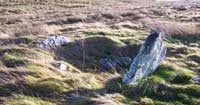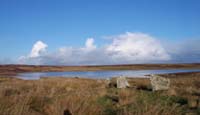 Across Scotland during the 3rd and 2nd millennium BC new pottery styles emerged, known as beakers, and bronze largely replaced stone for the manufacture of tools and weapons. Gold and bronze may have been the new form of wealth.
Across Scotland during the 3rd and 2nd millennium BC new pottery styles emerged, known as beakers, and bronze largely replaced stone for the manufacture of tools and weapons. Gold and bronze may have been the new form of wealth.
During this time we get glimpses of these early metalworkers in many forms. The working of metals in Caithness is slight, although the recovery of gold armlets from Hillhead is a good example of the metal objects circulating around 3000 years ago. Burial was at first by inhumation in individual graves, often accompanied by pots and by jet necklaces, and then by cremation in large pottery urns. Cists were often inserted into earlier buildings, as at Yarrows North chambered cairn. Others occur in unmarked cemeteries; others were covered by cairns. Like the earlier period evidence of settlement is rare although it is likely that families lived in some of the numerous hut circles, low timber or stone walled houses, scattered across Caithness.
 A distinctive group of monuments, which may date to this time, are the various stone settings. Standing stones, on their own or in pairs, are dotted across the landscape, as at Ranrag (ND177449). The impressive stone circle at Guidebest is one of the few examples in the county. Related to stone circles are the unusual U-shaped stone settings, as at Achavanich and Broubster. Stone rows may also have been built during this time. These remarkable monuments, characterised by long rows of small standing stones grouped together either in large fan-shaped settings, or running parallel to one another, often consist of hundreds of standing stones standing no more than 50cm high.
A distinctive group of monuments, which may date to this time, are the various stone settings. Standing stones, on their own or in pairs, are dotted across the landscape, as at Ranrag (ND177449). The impressive stone circle at Guidebest is one of the few examples in the county. Related to stone circles are the unusual U-shaped stone settings, as at Achavanich and Broubster. Stone rows may also have been built during this time. These remarkable monuments, characterised by long rows of small standing stones grouped together either in large fan-shaped settings, or running parallel to one another, often consist of hundreds of standing stones standing no more than 50cm high.
Few of these monuments have been excavated, so it is difficult to be sure of their date or function. Stone rows, for example, may date to around 2200-1700BC although it is equally possible that, as with the other stone settings, they may be earlier. There is also little evidence as to what these stones were used for. Some people believe they were lunar observatories, others believe they were part of a ritual landscape or territorial markers.